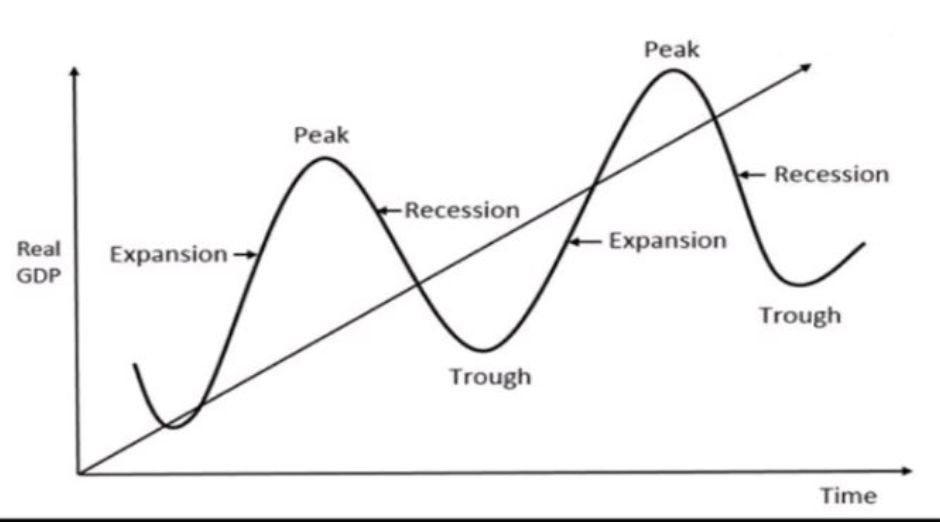Meaning:
The term “trade cycle,” also known as the business cycle or economic cycle. It refers to the recurrent fluctuations in economic activity that occur over time in a market economy. These fluctuations typically involve changes in levels of production, employment, investment, and consumption, among other economic variables. The Phases of trade cycle is characterized by alternating periods of expansion (growth) and contraction (recession) in economic activity.
Phases of Business Cycle:
A business cycle is commonly divided into four
- Prosperity phase: Expansion on upswing
- Recessionary face: A turn from prosperity to depression
- Depressionary phase: Contraction or down swing
- Revival or recovery phase: The turn from depression to prosperity.

- Prosperity phase : Heberler defines prosperity as a state of affairs in which the real income consumed, real income produces and level of employment are high or rising and there are no idol resources or unemployed workers or very few of either. The characteristics feature of prosperity are:
- A high level of output and trade
- A high level of effective demand
- High marginal efficiency of capital
- Price inflation
- A rising structure of interest rate
- The large expansion of bank credit
- Overall business optimism
- Tendency of the economy to operate almost at full capacity along its production possibility Frontier.
- Recession: Where prosperity ends the recession begins. Recession relates turning point rather than a phase it last relatively for a short period of time. It marks the point at which the forces that makes for contraction finally win over the forces of expansion liquidation in the stock market, relevant to borrow bank loan and decline in prices are its outward symptoms. The stock market is the first to experience that downfall as they will be sudden and violent changes in the prevailing atmosphere during recession. Businessman loses confidence everyone feels pessimistic about the future profitability of investment. Hence investment will be drastically curtailed and production of capital goods industries will fall.
During the recessionary face the banking system and the people in general try to attend great liquidity. Therefore credit sharply contracts, business expansion stops, orders are cancelled and workers are laid off. There is a general drive to contract the scale of operation, leading to increase in unemployment. Thus income throughout the economy falls. Reduced income causes profit and business activity declines.
- Depression: During depression the most deplorable condition prevails in the economy. Real income consumer, real income produce and the rate of unemployment fall or reach subnormal levels due to the idol resources and capacity. The characteristics feature of depression are the reverses of prosperity.
- Shrinkage in the volume of output trade and transaction
- Rise in the level of unemployment
- Price deflation
- Fall in the aggregate income of the community
- Fall in the structure of the interest rates
- Curtailment in consumption expenditure and reduction in the level of effective demand
- Collapse of the marginal efficiency of capital and decline in investment demand function
- Contraction of bank credit etc.
In short a depressionary period is characterized when overall curtailment of aggregate economic activity at its bottom. Thus depression and prosperity differ in degree rather than in kind. In the former economic activity at its through while in the latter, economic activity is at its peak.
- Recovery phase: The revival or recovery face referred to the lower turning point at which an economy undergoes changes from depression to prosperity with an improvement in demand for capital goods, recovery sets in. when the demand for consumption puts rises or when the capital stock increases de demand for capital goods will rise and new investment will be induce such induced investment will cause a rise in employment and income. the increase income in turn will lead to a rise in consumption which will push up the demand further in which in turn will leads the rise in prices, profit, further investment, employment and income. Once the expansionary movement starts this is how it gathers momentum during the revival period, level of employment output and income slowly improves stock markets becomes more sensitive during this period.
also read: explain the keynes theory of employment.